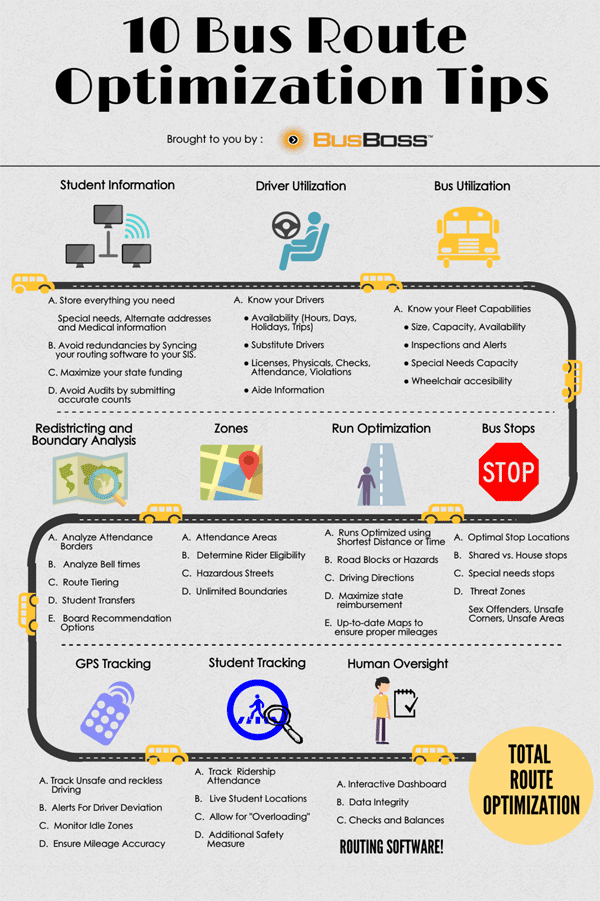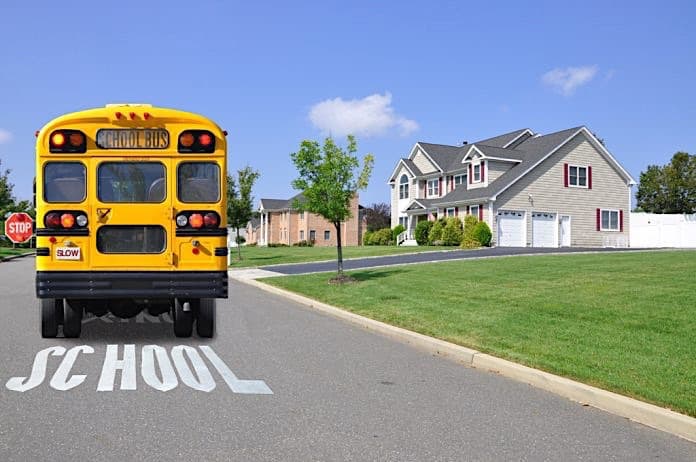Bus route optimization is centered on one system to streamline your fleet management so it’s efficient and safe for students.
Here’s how:
1. Maintain accurate student information.
Keep up-to-date student information to make quick decisions and maximize state reimbursements via accurate reporting. Have one location to access general info, safety info, emergency contacts and special requirements.
2. Store driver information centrally.
Document scheduling info, attendance, recertification testing and violations. Alerts are helpful for driver license renewals to further streamline your school bus routing.
3. Keep a fleet record handy to make quick changes.
Have a record of every vehicle in your fleet: type, capacity, special equipment and inspection date. If you understand your fleet and its capabilities, you utilize them better for bus route optimization.
4. Maximize groupings of bus stops.
The more often the bus stops, the longer it idles and wastes gas. Maximizing the walk-to-stop distances to create optimal group stops may lessen the amount of stops so you produce significant savings.
5. Update/alter bus routes quickly for efficiency.
Bus route optimization is a balance between cost-effective options and also keeping students safe. To maintain balance and efficiency, you need a simple way to generate multiple variations of your routes without affecting your current routes.
6. Define district rider zones.
Defining school specific rider zones ensures you only transport eligible riders. Zones can also be used when you create routes that avoid sex offender and threat zones to ensure student safety.
7. Analyze redistricting boundaries.
Understand how district boundaries impact school bus routing. Analyze attendance borders and bell times to compare combined or tiered routes, which could save you thousands on fuel and fleet maintenance.
8. Use GPS vehicle tracking for routing insight.
Invest in GPS vehicle tracking to estimate fuel and maintenance costs by knowing the actual miles traveled. You’re also alerted, in real time, when a bus deviates from a route or is speeding or idling too much.
9. Use student GPS tracking to optimize ridership.
With student tracking, you can capture accurate ridership attendance to understand what stop locations aren’t being utilized. Student tracking also gives you a record of where a student got on or off a bus in case of an emergency.
10. Avoid human oversight with dashboard alerts.
If you do routing manually, you don’t have checks and balances for missing or incorrect info. Investing in bus routing software with dashboard alerts ensures data integrity, the most important route optimizer tip of all.
 Sonia Mastros is co-founder, president and chief financial officer of BusBoss and Orbit Software Inc. Mastros, a native of Puerto Rico, has a 17-year history of working with school districts to develop sophisticated school bus routing software and student GPS tracking products for optimizing routes, improving student safety and alleviating parental concerns. She can be reached at soniasr@orbitsoftware.net. For more information, visit www.busboss.com or call (484) 941-0820.
Sonia Mastros is co-founder, president and chief financial officer of BusBoss and Orbit Software Inc. Mastros, a native of Puerto Rico, has a 17-year history of working with school districts to develop sophisticated school bus routing software and student GPS tracking products for optimizing routes, improving student safety and alleviating parental concerns. She can be reached at soniasr@orbitsoftware.net. For more information, visit www.busboss.com or call (484) 941-0820.



















